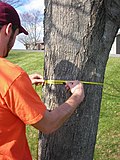This article contains historical images which have been upscaled using AI .(August 2025) |

Caulk boots or calk boots [1] (also called cork boots, timber boots, logger boots, logging boots, or corks) [2] are a form of rugged spike-soled footwear that are most often associated with the timber industry. [3] They are worn for traction in the woods and were especially useful in timber rafting. [4] These boots were part of the traditional lumber worker's basic equipment, along with axe, peavey and crosscut saw. [5] [6] [7]
Contents
Caulk boots are distinguished by their soles' steel spikes (calks) added for traction. They are typically made of leather or rubber uppers extending over the ankle, with a thick rubber sole. Ceramic calks are also available and have been reported to be less prone to wear and damage than steel. [8] In spite of their cost (often more than $400, as of 2015), caulk boots are usually the preferred footwear of experienced forest workers because of improved safety by reducing slips, trips, and falls when workers are traversing through logging slash, especially during wet weather. [8]
